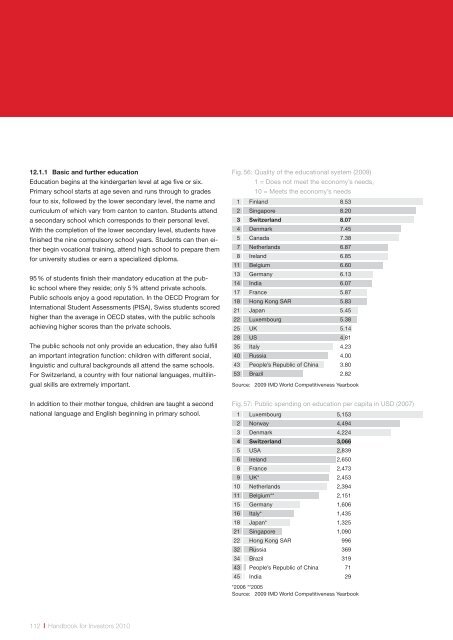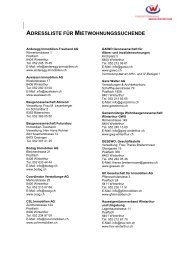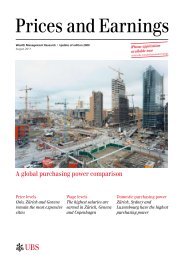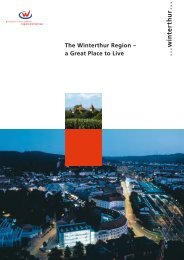Handbook for Investors. Business location in Switzerland.
Handbook for Investors. Business location in Switzerland.
Handbook for Investors. Business location in Switzerland.
You also want an ePaper? Increase the reach of your titles
YUMPU automatically turns print PDFs into web optimized ePapers that Google loves.
12.1.1 Basic and further education<br />
Education beg<strong>in</strong>s at the k<strong>in</strong>dergarten level at age five or six.<br />
Primary school starts at age seven and runs through to grades<br />
four to six, followed by the lower secondary level, the name and<br />
curriculum of which vary from canton to canton. Students attend<br />
a secondary school which corresponds to their personal level.<br />
With the completion of the lower secondary level, students have<br />
f<strong>in</strong>ished the n<strong>in</strong>e compulsory school years. Students can then either<br />
beg<strong>in</strong> vocational tra<strong>in</strong><strong>in</strong>g, attend high school to prepare them<br />
<strong>for</strong> university studies or earn a specialized diploma.<br />
95 % of students f<strong>in</strong>ish their mandatory education at the public<br />
school where they reside; only 5 % attend private schools.<br />
Public schools enjoy a good reputation. In the OECD Program <strong>for</strong><br />
International Student Assessments (PISA), Swiss students scored<br />
higher than the average <strong>in</strong> OECD states, with the public schools<br />
achiev<strong>in</strong>g higher scores than the private schools.<br />
The public schools not only provide an education, they also fulfill<br />
an important <strong>in</strong>tegration function: children with different social,<br />
l<strong>in</strong>guistic and cultural backgrounds all attend the same schools.<br />
For <strong>Switzerland</strong>, a country with four national languages, multil<strong>in</strong>gual<br />
skills are extremely important.<br />
Fig. 56: Quality of the educational system (2009)<br />
1 = Does not meet the economy’s needs,<br />
10 = Meets the economy’s needs<br />
1 F<strong>in</strong>land 8.53<br />
2 S<strong>in</strong>gapore 8.20<br />
3 <strong>Switzerland</strong> 8.07<br />
4 Denmark 7.45<br />
5 Canada 7.38<br />
7 Netherlands 6.87<br />
8 Ireland 6.85<br />
11 Belgium 6.60<br />
13 Germany 6.13<br />
14 India 6.07<br />
17 France 5.87<br />
18 Hong Kong SAR 5.83<br />
21 Japan 5.45<br />
22 Luxembourg 5.38<br />
25 UK 5.14<br />
28 US 4.81<br />
35 Italy 4.23<br />
40 Russia 4.00<br />
43 People’s Republic of Ch<strong>in</strong>a 3.80<br />
53 Brazil 2.82<br />
Source: 2009 IMD World Competitiveness Yearbook<br />
In addition to their mother tongue, children are taught a second<br />
national language and English beg<strong>in</strong>n<strong>in</strong>g <strong>in</strong> primary school.<br />
Fig. 57: Public spend<strong>in</strong>g on education per capita <strong>in</strong> USD (2007)<br />
1 Luxembourg 5,153<br />
2 Norway 4,494<br />
3 Denmark 4,224<br />
4 <strong>Switzerland</strong> 3,066<br />
5 USA 2,839<br />
6 Ireland 2,650<br />
8 France 2,473<br />
9 UK* 2,453<br />
10 Netherlands 2,394<br />
11 Belgium** 2,151<br />
15 Germany 1,606<br />
16 Italy* 1,435<br />
18 Japan* 1,325<br />
21 S<strong>in</strong>gapore 1,090<br />
22 Hong Kong SAR 996<br />
32 Russia 369<br />
34 Brazil 319<br />
43 People’s Republic of Ch<strong>in</strong>a 71<br />
45 India 29<br />
*2006 **2005<br />
Source: 2009 IMD World Competitiveness Yearbook<br />
112 <strong>Handbook</strong> <strong>for</strong> <strong>Investors</strong> 2010









